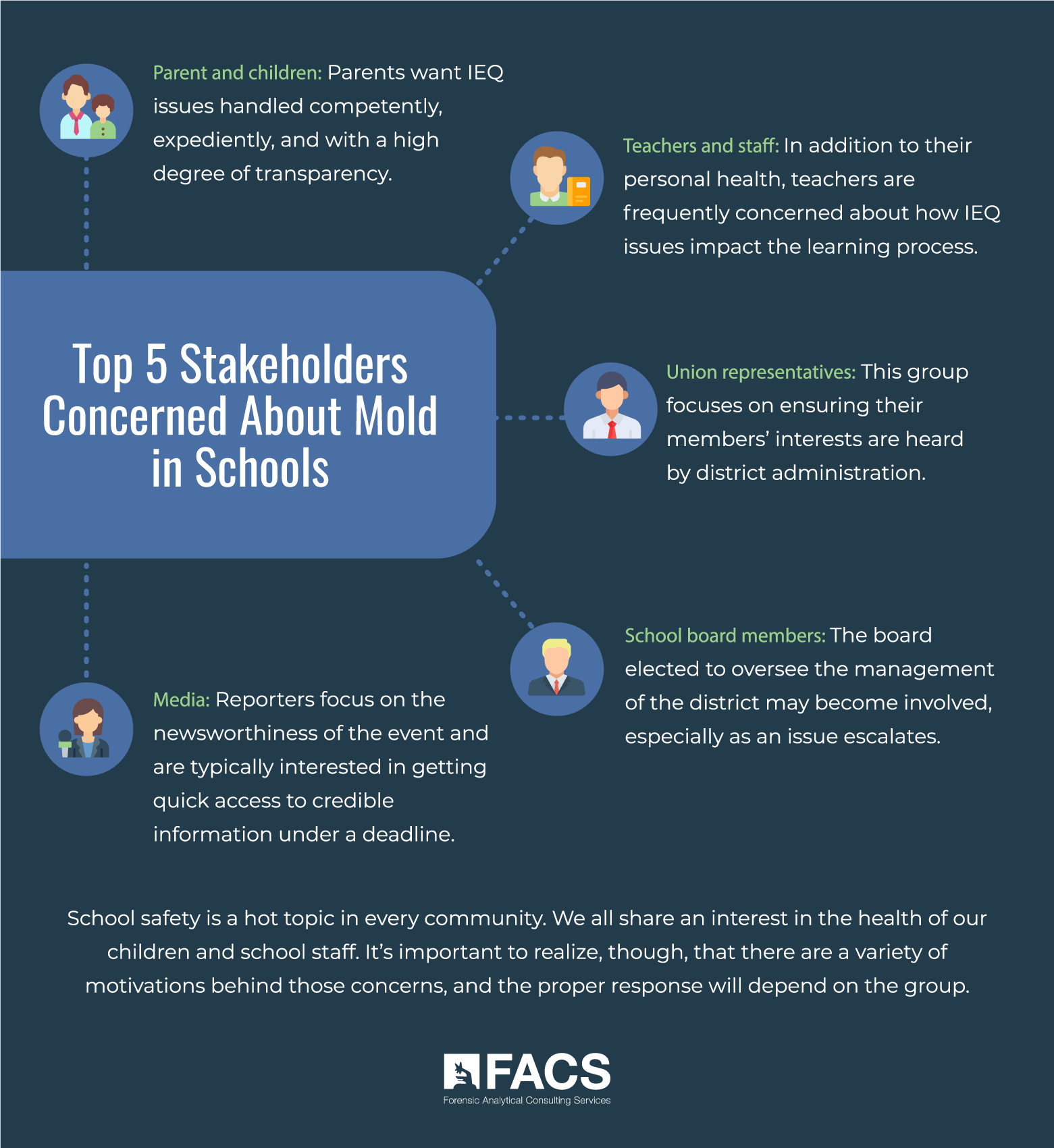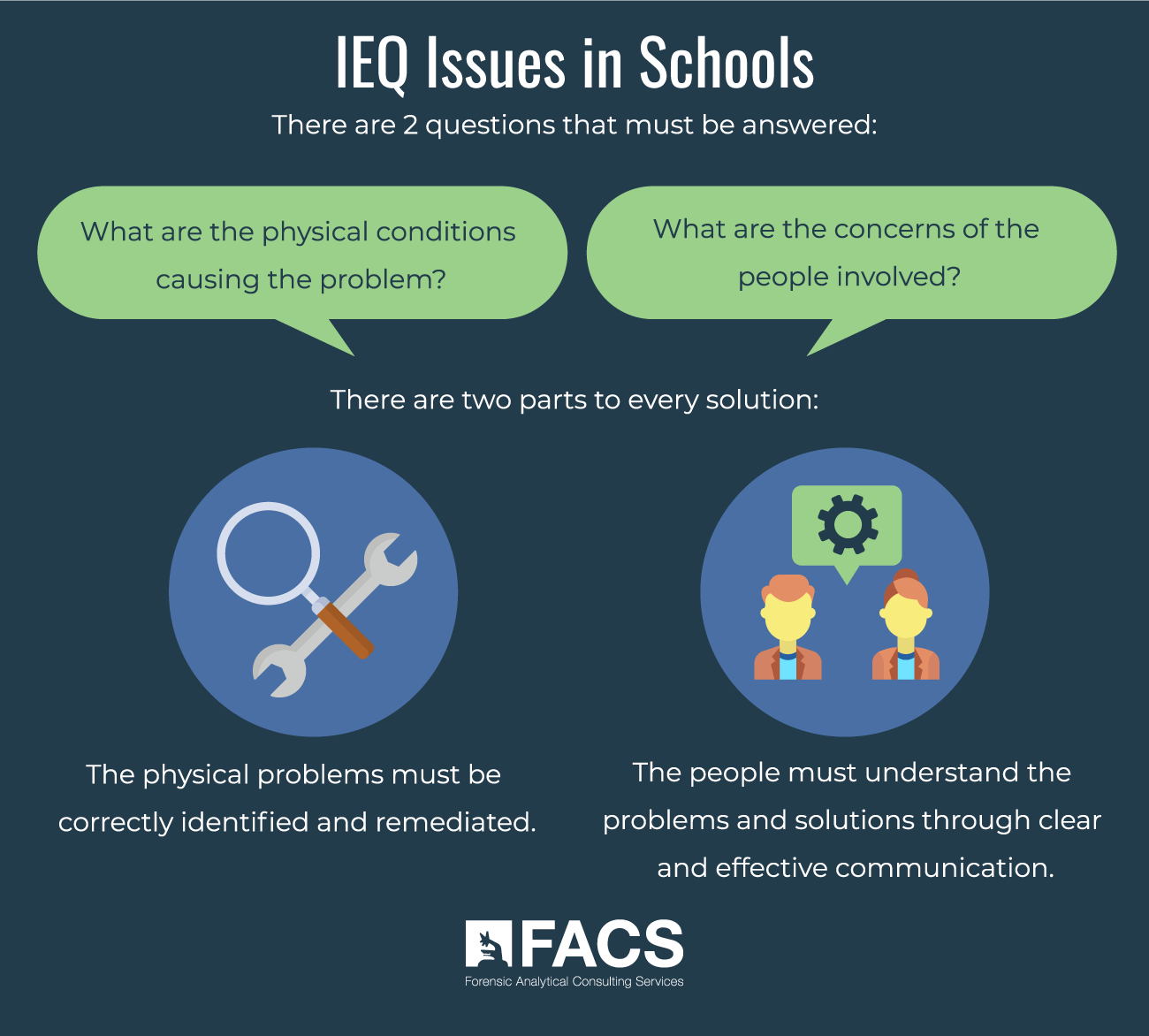Schools are ground zero for indoor environmental quality (IEQ) concerns. Asbestos, lead, mold, PCBs, and many other issues become especially sensitive when classrooms or other student-occupied spaces are involved.
FACS experts are often asked to do more than develop a plan for the abatement of hazardous materials. The schools we serve depend on our IEQ experts to answer the many questions posed by parents, teachers, school administrators, and others.
My aim here is to briefly describe the process FACS teams follow to help our clients understand the issues at hand. It is crucial that response team leaders know how to address the problem quickly and alleviate the anxiety that always arises when mold or other potentially toxic substances are discovered on school property.

Who Cares About Mold in Classrooms and Other School IEQ Concerns?
School safety is a hot topic in every community. We all share an interest in the health of our children and school staff. It’s important to realize, though, that there are a variety of motivations behind those concerns, and the proper response will depend on the group addressed.
Parents and children: Parents want IEQ issues handled competently, expediently, and with a high degree of transparency. When discussing an issue at a school meeting, parents may weigh in from an angle related to their professional expertise. For example: “I am a doctor and I can tell you that black mold exposure does XYZ…”. It is critical that someone on the presentation team can respond to all challenges and suggestions with evidence-based science and practical experience.
Teachers and staff: In addition to their personal health, teachers are frequently concerned about how IEQ issues impact the learning process. Often, teachers worry that school administrators haven’t heard their concerns or aren’t taking them seriously. Clear communication and a common ground approach are essential.
Union representatives: This group focuses on ensuring their members’ interests are heard by district administration. Ongoing issues unrelated to IEQ often get in the way and can cloud the problem at hand. Presenters must be prepared to take the lead and bring the conversation back to focusing on the health and safety of students, teachers, and others who occupy the building.
School board members: The board elected to oversee the management of the district may become involved, especially as an issue escalates. Board members must balance the concerns of their constituents with the mission of their district. FACS staff act as third-party experts to inform this process and facilitate the solutions to balance the concerns of all parties.
Media: Reporters focus on the newsworthiness of the event. They are typically interested in getting quick access to credible information and are usually under deadline. While FACS experts can’t dictate what is in news articles, they can provide objective data and technical understanding. Our aim is to help answer hard questions with composure, compassion, and an eye toward shared interests and solutions.
District administration: Risk managers and maintenance directors are most frequently tasked with resolving IEQ issues. They must address issues like workers compensation claims, lawsuits (whether threatened or filed), insurance claims, and budget considerations. FACS teams can provide objective data, cost estimates, expert testimony, and other resources district administrators need to get past the problem and into the solution.

The Industrial Hygienist’s Role in Solving School IEQ Problems
In resolving IEQ issues in schools, the industrial hygienist’s (IH) ability to connect with stakeholders is often just as critical a factor as technical prowess. Understanding situations from a variety of perspectives is key.
Mold in classrooms and other IEQ issues are often blown out of proportion by alarmist information gathered from the internet or other outlets. A one-sided or incomplete understanding of IEQ concerns can cause stakeholders to jump to conclusions and develop worst-case assumptions. An alarmist attitude is quick to spread and can lead to panic. If IEQ cases aren’t addressed quickly, concerns can turn into outrage and lead to an adversarial relationship between stakeholders — thereby hindering prospects for rapid resolution.
It is essential that the IEQ leader and response team members adopt a supportive and professional attitude with all concerned.
Here’s a short list of the characteristics you can expect from a FACS team:
Learn: Leaders must demonstrate a genuine desire to learn about and help resolve stakeholder concerns. Competence and credibility must be established, but not only by focusing on personal capability and experience, but by supporting all assertions with sound reasoning and defensible data from authoritative sources.
Listen: Leaders must encourage stakeholders to express their concerns, observations and ideas. They should remember to consider not only the likely causes of symptoms from a technical perspective, but address the situation from the belief structure and reasoning methods employed by stakeholders. No question or concern is ever ridiculed or dismissed out of hand.
Educate: Those in charge of the response must educate stakeholders on the issues. It is essential that accurate histories are provided and transparency of data is promoted. The goal is to help stakeholders verify the information provided and join forces to move towards a solution.
Establish cooperation. If stakeholders don’t believe in the process, they won’t accept the conclusions. Team leaders must get buy-in on the investigative methodology and remediation pathway. Everyone involved should share in understanding both the problem and the solution.
Keep constant contact. Good faith and agreed-upon pathways begin to fade as soon as the meeting is over. Leadership must establish a solid communication plan to keep everyone informed. A regular flow of messages should point back to the action plan and highlight the progress being made. Leaders should follow through on commitments and meet all time-based promises.
Successful resolution of IEQ issues often depends just as much on the leader’s ability to educate stakeholders on environmental health as on the specific technical issues at hand. That’s why expert third-party assistance is often indispensable. Access to believable science-based knowledge and the presence of someone with hands-on experience is often the primary key to a quick and satisfactory resolution. Time and time again, we have seen “impossible situations” cool down and agreements reached when FACS experts are called in to help.
The Technical Aspects to School IEQ Problems
While communication can be the make-or-break issue, IEQ investigations still rely on technical knowledge and data. Fortunately, the technical aspects of IEQ issues in schools are usually uncomplicated and rarely involve novel hazards. Identifying solutions, however, can be challenging.
Investigators should have knowledge of approaches that address a variety of commonly encountered health issues in schools:
- Ventilation problems arise frequently in school buildings. They can be corrected, for the most part, through proper operation and maintenance of systems.
- Temperature control issues are typically straightforward, but they can be challenging due to occupants’ differing preferences and system limitations.
- Leaks and areas where moisture collects are often easy to see, but tough to trace and correct. The maintenance policy should be proactive at identifying and correcting moisture issues.
- Routine cleaning in classrooms must not be taken lightly. Concerns about the quality of cleaning can often be addressed by empowering occupants with better resources and opening lines of communication with custodial staff.
- Concerns regarding cancer clusters are not uncommon. These can be addressed through assessments for potential carcinogens and by educating stakeholders regarding the complexities of such associations and resources available to address them. Both the CDC and the State of California have developed considerable data and resources about cancer clusters.
In addition to commonly encountered issues, research and guidelines developed by public health agencies and organizations can generate concerns. Examples include caulking materials containing polychlorinated biphenyls (PCBs), lead in drinking water, and the Lead Renovation, Repair, and Painting rule (RRP).
Finally, there is the wildcard of media coverage. Stories about environmental health issues on the news one night, become the crisis of the next school day.
Prevention and Planning to Combat School IEQ Problems
Many IEQ problems in schools can be prevented by issue awareness and proper building maintenance. FACS experts work with school staff members to build capability and confidence.
When incidents do arise, properly planned and executed responses can significantly reduce impacts upon all stakeholders and on the school budget. The EPA has developed an extensive set of resources to help schools manage IEQ issues, most of which are available in the Healthy School Environments section of their website. Go there to find a growing collection of resources dedicated to sustainable design of schools. You can also get access to resources you can use to assess environmental issues at your school.
Unfortunately, those responsible for addressing IEQ issues in schools frequently find themselves wearing more hats and managing ever leaner budgets. Little time and few resources complicate the situation.
FACS experts help schools identify approaches that offer the greatest return on investment and guide administration in the implementation of a program compatible with available resources.
School environments challenge scientists with a complex set of dynamics, but FACS hygienists are uniquely suited to tackle those challenges.

At FACS, we go the extra mile to help provide a health-sensitive environment conducive to the education of our children. We’ve found there are two questions that must be answered every time mold in the classroom or another indoor air quality issue affects schools:
- What are the physical conditions causing the problem?
- What are the concerns of the people involved?
We’ve also discovered there are two parts to every solution:
- The physical problems must be correctly identified and remediated
- The people must understand the problems and solutions through clear and effective communication
Our decades of experience and thousands of hours of investigative work on IEQ cases has repeatedly proven this essential principle: Until both the science and the people factors are effectively addressed, the problem will not go away. .
FACS can help you establish a strategic plan to prevent, respond to, and manage the remediation of school IEQ issues. Don’t wait to protect your people, your resources, and your reputation. Let’s talk today.
Contact FACS by telephone here: 888-711-9998
Contact FACS online here: Ask FACS